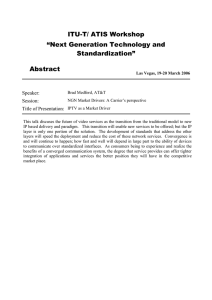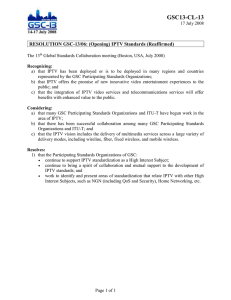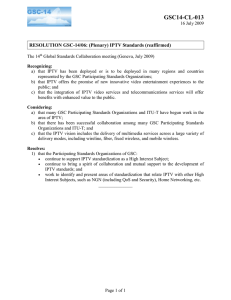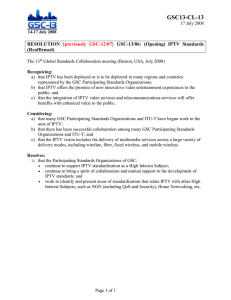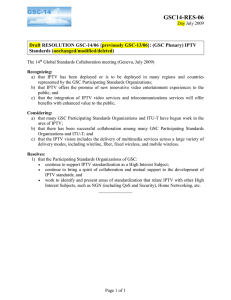www.ijecs.in International Journal Of Engineering And Computer Science ISSN:2319-7242
advertisement
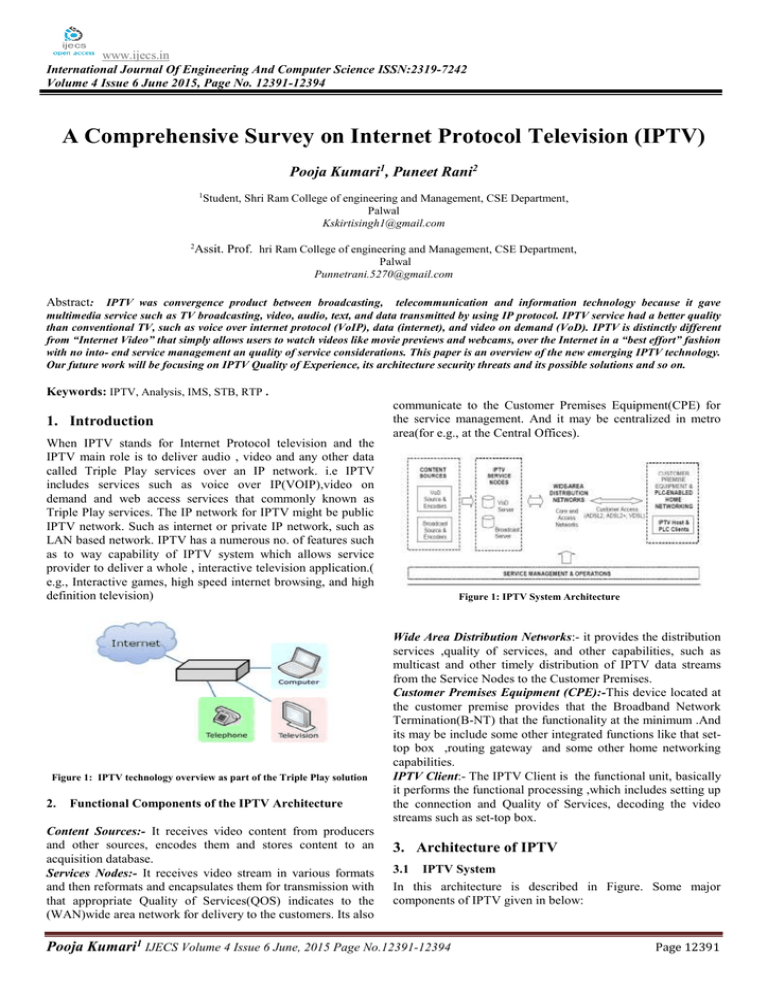
www.ijecs.in International Journal Of Engineering And Computer Science ISSN:2319-7242 Volume 4 Issue 6 June 2015, Page No. 12391-12394 A Comprehensive Survey on Internet Protocol Television (IPTV) Pooja Kumari1, Puneet Rani2 1Student, Shri Ram College of engineering and Management, CSE Department, Palwal Kskirtisingh1@gmail.com 2 Assit. Prof. hri Ram College of engineering and Management, CSE Department, Palwal Punnetrani.5270@gmail.com Abstract: IPTV was convergence product between broadcasting, telecommunication and information technology because it gave multimedia service such as TV broadcasting, video, audio, text, and data transmitted by using IP protocol. IPTV service had a better quality than conventional TV, such as voice over internet protocol (VoIP), data (internet), and video on demand (VoD). IPTV is distinctly different from “Internet Video” that simply allows users to watch videos like movie previews and webcams, over the Internet in a “best effort” fashion with no into- end service management an quality of service considerations. This paper is an overview of the new emerging IPTV technology. Our future work will be focusing on IPTV Quality of Experience, its architecture security threats and its possible solutions and so on. Keywords: IPTV, Analysis, IMS, STB, RTP . 1. Introduction When IPTV stands for Internet Protocol television and the IPTV main role is to deliver audio , video and any other data called Triple Play services over an IP network. i.e IPTV includes services such as voice over IP(VOIP),video on demand and web access services that commonly known as Triple Play services. The IP network for IPTV might be public IPTV network. Such as internet or private IP network, such as LAN based network. IPTV has a numerous no. of features such as to way capability of IPTV system which allows service provider to deliver a whole , interactive television application.( e.g., Interactive games, high speed internet browsing, and high definition television) Figure 1: IPTV technology overview as part of the Triple Play solution 2. Functional Components of the IPTV Architecture Content Sources:- It receives video content from producers and other sources, encodes them and stores content to an acquisition database. Services Nodes:- It receives video stream in various formats and then reformats and encapsulates them for transmission with that appropriate Quality of Services(QOS) indicates to the (WAN)wide area network for delivery to the customers. Its also communicate to the Customer Premises Equipment(CPE) for the service management. And it may be centralized in metro area(for e.g., at the Central Offices). Figure 1: IPTV System Architecture Wide Area Distribution Networks:- it provides the distribution services ,quality of services, and other capabilities, such as multicast and other timely distribution of IPTV data streams from the Service Nodes to the Customer Premises. Customer Premises Equipment (CPE):-This device located at the customer premise provides that the Broadband Network Termination(B-NT) that the functionality at the minimum .And its may be include some other integrated functions like that settop box ,routing gateway and some other home networking capabilities. IPTV Client:- The IPTV Client is the functional unit, basically it performs the functional processing ,which includes setting up the connection and Quality of Services, decoding the video streams such as set-top box. 3. Architecture of IPTV 3.1 IPTV System In this architecture is described in Figure. Some major components of IPTV given in below: Pooja Kumari1 IJECS Volume 4 Issue 6 June, 2015 Page No.12391-12394 Page 12391 a) Acquisition servers:- They add DRM metadata and encode video. b) IP routers:- They provide fast reroute in that case if routing are failures. Basically they route IP packets. c) Distribution Servers:- They are provide QOS control and caching. d) Set-Top –Boxes(STB):-This device on the customer side in that interfaces with the user terminal (e.g., PC, TV, laptop and others)with a Digital Subscriber Line(DSL). e) VoD creators and servers:- They retain the library of encoded VoD content to provide VoD services 3.3 Peer-to-Peer IPTV Architecture: In this Architecture for a Peer-to-Peer(P2P) IPTV distribution, there is a group and a source of peers as a torrent. Each peer receives many packets from the source and from other peers as shown in Figure. . Figure 4: Peer-to-Peer IPTV Architecture 4. IPTV Set-Top Box (STB) Figure 2: Basic IPTV System 3.2 IP-multicast IPTV Architecture IP-multicast is a method of sending IP packets to a group of interested receivers. As shown in Figure , AT&T U- Verse adopts the IP multicast architecture. When a TV program is encoded at the super hub office (SHO), and then delivered via multicast through video hub offices(VHO), intermediate offices(IOs), central offices(Cos), Digital Subscriber line access multiplexers(DSLAM), & residential gateway(RG), to the TV Set-Top-Boxes(STB). Set-Top box is an IPTV device that is used to receive and decode digital television broadcast and to turn that signal into content which is then displayed on a TV screen or any some other display devices. Professional Set-Top box : It’s referred to as Integrated Receiver Decoders (IRD) are professional method of the broadcasting audio and video contents to the display devices. They are technically superior. (For e.g. Tornado M10 Set-Top box) Figure 5: Professional Set-Top box Hybrid IPTV Set-Top box It is designed basically to deliver video contents. This allows viewers to view broadcast television and internet video on their display along with IPTV services such as VOD. A new consumer television experience can created internet browser. Figure 3: IP-multicast IPTV Architecture Figure 6: Hybrid IPTV Set-Top box Wireless IPTV Set-Top box: It is to deliver IPTV contents through a wireless network connection. Its connect to displays Pooja Kumari1 IJECS Volume 4 Issue 6 June, 2015 Page No.12391-12394 Page 12392 using high definition multimedia interface (HDMI) and S-video interface that can take input from the internet and deliver it to the display device. It can deliver high quality audio and video those contents to the displays with high speed network connection. Figure 7: Wireless IPTV Set-Top box 5. Protocols used for IPTV A. RTP: Real –time Transport Protocol provides many packet format for delivering video and audio contents through IP network. RTP is commonly used in some streaming media services like including telephony & video teleconference applications services. This is used for streaming channels and it’s controlled by the Real Streaming Time Protocol (RSTP). B. RTSP: Its stand for Real Time Streaming Protocol or controlling network protocol It’s used to establish and control media sessions from the server to the user. The media servers issue pauses and play commands to easily control that those transmissions of media files from the server. In RTSP Streaming of data is one –directional. Data streams can be sent from the server to the user RTSP is used to control all unicast and multicast streams. C. PIM: Protocol-Independent Multicast (PIM) is a collection of multicast routing protocols that can provide data distribution through IP network such as the internet, LAN (Local Area Network), and WAN (Wide Area Network). PIM is independent and it uses routing information provided by various routing protocols such as BGP (Border Gateway Protocol) In IPTV, PIM is commonly used to route IPTV multicast streams between networks. D. IGMP: IGMP stands for The Internet Group management protocol. Its used to manage membership in IP multicast groups. This protocol is basically used in online streaming video and gaming. IGMP is main part of the multicast specification over IP network. It is used to change from one TV channel to another TV channel. 6. CONCLUSIONS AND FUTURE WORK This paper describes the various standardization, ways of deployment, implementation and evaluation of IPTV service, performance capacity and security. The objectives of various IPTV approach have been explained and also reasons and advantages identified for the presented concept. Main components of IPTV service architecture as well as the roles of different functions have been explained in the paper. In our future work we plan to elaborate a further interaction between IMS mechanisms and IPTV service. First we want to enable a dynamic adaptation of IPTV QoS parameters depending on the network resources available for the user at any time. References [1] W. Hrudey and Lj. Trajkovic, "Mobile Wimax MAC and PHY layer optimization for IPTV," Journal of Mathematical and Computer Modeling, Elsevier, Mar. 2011, vol. 53, pp. 2119–2135. [2] R. Gill, T. Farah, and Lj. Trajkovic, “Comparison of WiMAX and ADSL performance when streaming audio and video content,” OPNETWORK 2011, Washington, DC, Aug. 2011. [3] D.J. Reid, A. Srinivasan, and W. Almuhtadi, "QoS Performance Testing of Multimedia Delivery over WiMAX Networks," First International Conference on Data Compression, Communications and Processing (CCP), 2011, vol., no., pp. 271-274. [4] W. Hrudey, and Li. Trajkovic, “Mobile WiMAX MAC and PHY layer optimization for IPTV”, Journal of Mathematical and Computer Modeling, Elsevier, Vol.53, pp. 2119–2135, 2011. [5] R. Gill, T. Farah, and Li. Trajkovic, “Comparison of WiMAX and ADSL performance when streaming au-dio and video content”, Proc. OPNETWORK 2011, Washington, DC, Aug. 2011. [6] J. Hamodi, and R. Thool, “Investigate The Perfor-mance Evaluation of IPTV over Wimax Networks”, International Journal of Computer Networks & Communications (IJCNC), Vol.5, No.1, pp. 81-95, 2013. [7] J. Hamodi, and R. Thool, “Performance Evaluation of IPTV over WiMAX Networks Under Different Terrain Environments”, International Journal of Engineering Inventions, Vol.2, No.2, pp. 21-25, 2013. [8] J. Hamodi, K. Salah, and R. Thool, “ Evaluating the Performance of IPTV over Fixed WiMAX”, Interna-tional Journal of Computer Applications, Vol.84, No.6, pp. 35-43, Dec. 2013. [9] J. Hamodi, R. Thool, K. Salah, A. Alsagaf, and Y. Holba, “Performance Study of Mobile TV over Mobile WiMAX Considering Different Modulation and Cod-ing Techniques”, Int. J. Communications,Network and System Sciences, Vol.7, No.1, pp. 10-21, Jan. 2014. [10] P. Telagarapu, G. Naidu, and K. Chiranjeevi, “Analy-sis of Coding Techniques in WiMAX”, International Journal of Computer Applications, Vol.22, No.3, pp. 19-26, 2011. [11] M.Singh, R.Uppal and J. Singh, “WiMAX with Dif-ferent Modulation Techniques and Code Rates”, In-ternational Journal of Information and Telecommuni-cation Technology, Vol.3, No.1, pp. 31-34, 2009. [12] Md. Islam, R. Mondal, and Md. Hasan, “Performance Evaluation of WiMAX Physical Layer under Adaptive Modulation Techniques and Communication Chan-nels”, International Journal of Computer Science and Information Security, Vol.5, No.1, pp. 111–114, 2009. [13] Md. Islam, and T. Isalm, “Performance of WiMAX Physical Layer with Variations in Channel Coding and Digital Modulation under Realistic Channel Conditions”, International Journal of Information Sci-ences and Techniques, Vol. 2, No. 4, pp. 39-47, 2012. [14] A. Rehman, T. Khan, and S. Chaudhry, “Study of WiMAX Physical Layer under Adaptive Modulation Technique using Simulink”, International Journal of Scientific Research Engineering & Technology, Vol.1, No.5, pp. 05-11, 2012. Pooja Kumari1 IJECS Volume 4 Issue 6 June, 2015 Page No.12391-12394 Page 12393 [15]A. Abdennour, “VBR Video Traffic Modeling and Synthetic Data Generation Using GA-Optimized Volterra Filters”, International Journal of Network Management, Vol.17, pp. 231-241, 2006. [16] H. Lee, T. Kwon, and D. Cho, “An enhanced uplink scheduling algorithm based on voice activity for VoIP services in IEEE 802.16d/e systems”, IEEE Communications Letters, Vol.9, No.8, pp. 691–692, 2005. [17] So-In. Chakchai, R. Jain, and A. Al-Tamimi, “A Scheduler for Unsolicited Grant Service (UGS) in IEEE 802.16e Mobile WiMAX Networks”, IEEE Systems Journal, Vol.4, No.4, pp. 487-494, 2010. Pooja Kumari1 IJECS Volume 4 Issue 6 June, 2015 Page No.12391-12394 Page 12394


